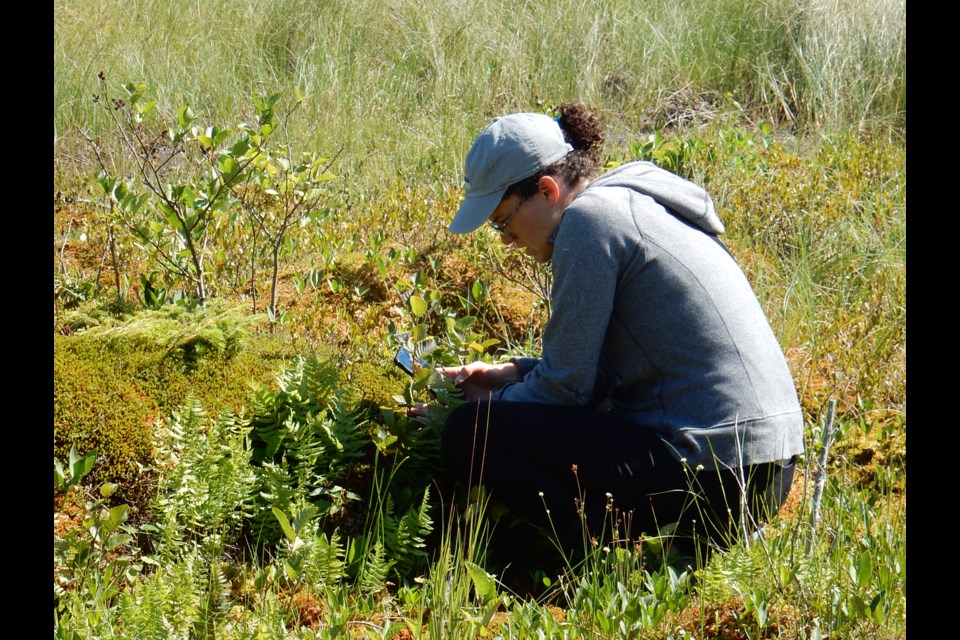THUNDER BAY – Two young researchers have returned from a stay on Porphyry Island with a trove of data on the island's natural life and an unforgettable experience.
Herglotz and Boudreault spent eight weeks on the small island, about 40 kilometres from Thunder Bay on the other side of the Sleeping Giant peninsula, gathering information on its flora, fauna and weather patterns.
The pair set out in late July, returning Sept. 21.
Much of the island is taken up by a provincial park, while the rest is occupied by the Porphyry Island Lighthouse, originally built in 1873. The pair’s only company on the island were a volunteer lighthouse keeper and cook with the Canadian Lighthouses of Lake Superior, along with the occasional visitor - that included two island-hopping bears, but more often boaters and sailors.
The opportunity came through the new Ocean Bridge Direct Action program, which aims to connect Canadian youth with field-based marine conservation research projects, in partnership with EcoSuperior, the local environmental non-profit.
The duo’s days on the island were largely spent cataloguing its natural diversity, with images and information uploaded to the publicly-available iNaturalist initiative. That helped grow the handful of plant and animal species identified on Porphyry to a list of hundreds.
Those include moose, bear, and a great number of birds and plant species.
With a hand from local climate researcher Graham Saunders, Herglotz and Boudreault also installed weather stations on the island, monitoring temperature, precipitation, wind, and cloud cover.
It’s information that could prove valuable in understanding the impacts of a warming climate on regional ecosystems, said Sue Hamel, EcoSuperior’s executive director.
“As humanity, including our region, is facing climate change, this kind of information is really important to start collecting, and having a baseline to compare over time so we can start tracking what’s happening and at what pace or scale,” she said.
One example is the presence of arctic-alpine plants, present in microclimates like Porphyry Island along Lake Superior, but normally found much further north.
According to a 2015 study, arctic disjunct plants tend to thrive along the shores of the lake in places where surface water temperatures do not exceed 15 degrees. Their disappearance could be one impact of climate change, as it warms Lake Superior.
Herglotz hoped the inventory they’d built could be used to track those impacts.
“If you don’t know what’s living somewhere, you’re not going to know when changes occur,” she explained. “Maybe in the future, they could look and see, ‘Well, we’re not seeing any butterwort plants here, and that could be due to a slight change in temperature.’”
Herglotz and Boudreault’s experience of island life over the eight weeks they spent on Porphyry was also incorporated into the Direct Action program, with the pair asked to pursue learning on the concept of forest therapy.
That involved a thorough literature review, as well as an experiential component involving a journal and regular time spent at a “heart spot” on the island.
The participants say the two-month immersion in nature, relying on limited amenities, was a major adjustment at first, but ultimately led to a deeper connection with the natural world.
“You could hear how strong the wind was without feeling it, by the sound of the waves,” said Boudreault. “We really got in sync with nature.”
Herglotz, who hails from London, Ontario, opted to stay in Thunder Bay for a while following her experience on the island - crediting the wonderful people she met in the area, including visitors to the island, for the decision.
Reacclimatizing to urban life has proven its own challenge.
“It definitely feels a bit strange not to be outside 90 per cent of the time,” she reflected.
The pair say the Ocean Bridge Direct Action Program offered valuable experience – of both the work and life variety.
“Ocean Bridge gave me hands-on experience, allowed me to travel, discover a new area of Canada, and of course live a real adventure of spending two months on an island,” said Boudreault, who hopes to apply his business administration background in the environmental non-profit sector.
For Herglotz, who holds an environmental studies degree, it was a chance to broaden her conservation field work experience, seeing species she wouldn’t find in southern Ontario.
She hopes youth from northwestern Ontario will have the opportunity to participate in similar opportunities in their own region in the future.
Hamel reports promising signs that could be in the works. EcoSuperior is working with Ocean Bridge and other organizations, hoping to offer more youth conservation opportunities. The organization is in active talks to serve as a Canadian Conservation Corps host, she said.
She credited support from local individuals and organizations who lent their expertise to the Porphyry Island project for helping open the door to future opportunities. Those included the Canadian Lighthouses of Lake Superior, the Lake Superior Living Labs Network, Lakehead University’s Claude E. Garton herbarium, ornithologist Brian Ratcliff, Saunders, and others.



